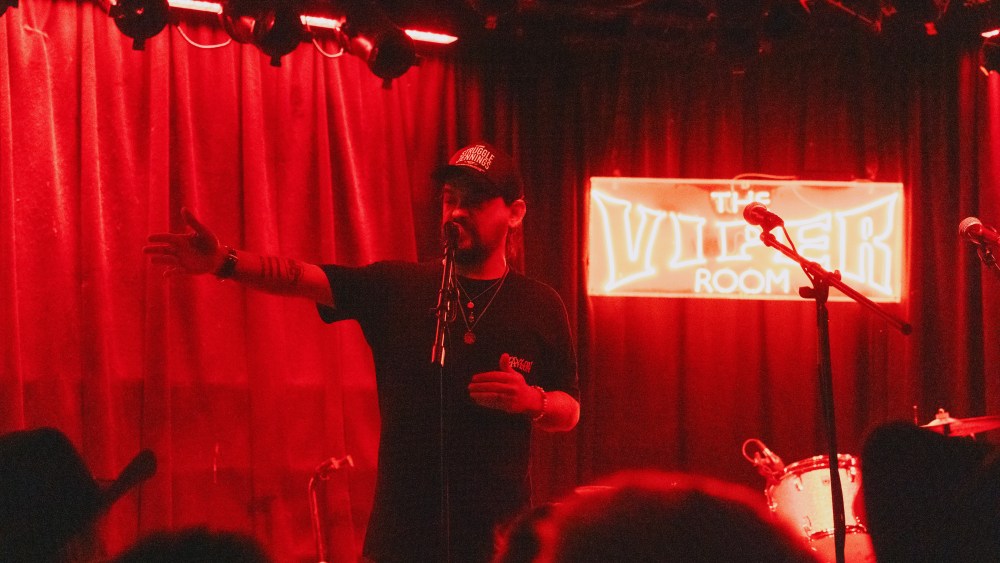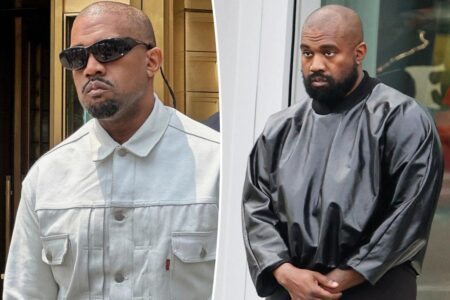There’s a new Waylon Jennings album coming out in October — that is, the first in a series of high-quality studio albums culled from material the late country legend left in the vault — and his son, Shooter Jennings, unveiled it for an invite-only crowd Monday night at the Viper Room. If four months out from the release date seems slightly early for a listening party, there was a harmonic convergence Shooter couldn’t resist: Monday was his dad’s 88th birthday, directly coinciding with Father’s Day.
The playback for the newly announced “Songbird” album — due Oct. 3 — was hardly the only bait for attendees. Following that, the surviving members of Waylon’s classic backing band, the Waylors, took the stage of the tiny West Hollywood club and performed their old boss’ classics on their own and with a succession of young bucks and buckettes, including Charley Crockett, Ashley Monroe, Elizabeth Cook, Jaime Wyatt and Shooter himself.
The crowd was ready for the country, as it were, and did more or less think Hank done it this way. As for the Waylors — currently comprised of the quartet of guitarist Gordon Payne, bassist Jerry Bridges, keyboardist Barny Robertson and backing vocalist Carter Robertson — they put the lie to “I Ain’t Living Long Like This.” (As does the Viper Room itself, which by most rights was destined to be torn down long ago, but endures, with a photo rendering of the proposed skyscraper for the block still hanging on the outside side wall.)
Charley Crockett and the Waylors
Emilia Paré
Performances by the guests ranged from Crockett picking off guitar leads as well as singing the been-around anthem “All Around Cowboy” to, on the less bad-ass side, Monroe bringing out the pathos in one of the all-time great lovelorn ballads, “Dreaming My Dreams.” With so many female singers on hand, someone was destined to claim the title of “Good-Hearted Woman,” and that was Cook, reprising Jennings’ classic co-write with Willie Nelson, while Wyatt was allowed to claim “I’ve Always Been Crazy.”
Although partygoers were allowed to bust their phones out for the live performance part of the evening, they were put in pouches for the album playback, with Shooter saying he was wary of leaks. He probably need not have worried about anyone’s ability to get a good capture of the audio above the din of a party with some certified shitkickers on hand. But to the extent that the songs came through clearly, it appeared that the younger Jennings has not overestimated the quality of the studio material he has uncovered — which will be spread out over three separate albums.
Waylon’s cover of Fleetwood Mac’s “Songbird” was issued Sunday on streaming services to preview the set(s) for fans, and it’s a wonder why his version never saw daylight before; even if his tone on the tune is slightly more stentorian than Christine Perfect’s, it works perfectly well. That track features backing vocals by Monroe and Cook and is the only number on the album that includes fresh contributions from anyone who was not part of Jennings’ recording circle back in the day, although Shooter did also bring the remaining Waylors back in to add new parts where there was something less than a full complement in the studio for the original recordings.
The material was all recorded during what could certainly be considered a peak period for Waylon, 1973-84. It was put down at the time by Jennings and his drummer/co-producer Richie Albright, with such additional guests as pedal steel guitarist Ralph Mooney, singer-songwriter Tony Joe White and Waylon’s wife (and Shooter’s mother), Jessi Colter. Shooter re-produced and mixed the project on Sunset Sound Studio 3’s 1976 DeMedio API mixing board, promising an analog feel, even though the original recordings, made before digital took over, had been stored on digital files.
Shooter told the Tennessean about finding the recordings in a family storage room. “When I first opened these drives housing the files, I saw that nothing was labeled. There were no songs,” Shooter Jennings recounted to The Tennessean. “There were Pro Tools sessions, but when you opened them, nothing was labeled. None of the tracks, like kick drum, bass, whatever. Right? So it was pretty overwhelming and it was a lot of files… We start going through this stuff and immediately were like, ‘What is this?’ It’s finished. It’s finished singles. Tons of it and all from these different era eras within a window from 1973 to 1984-85 for the most part.”

Shooter Jennings
Emilia Paré
Of adding more parts, Bridges told the paper, “ We’ve tried to keep the spirit alive ever since Waylon passed. Part of the original band has still been performing and it only made sense for the folks who helped create that sound to finish it. That’s not something a lot of people get to do.”
“What became very apparent to me was that my dad was recording constantly with his band the Waylors between tours,” Shooter said in an additional statement. “Just having won the David-and-Goliath battle against RCA for creative control and artistic freedom, Waylon was awarded the ability to record his music on his terms in his own studios, with his touring band, and without label oversight and without any outside influence.”
The other two albums will not follow immediately. “The next few years are going to be full of some of the most exciting musical moments that the world never knew they were going to hear,” Shooter said. “This project has given me an entirely new chapter in my relationship with my father and working on this music has brought a whole new understanding about how, when and why my dad made music. The hard work is there on the tapes and the passion and the soul within is as alive today as it was the day it was recorded.”
Read the full article here








